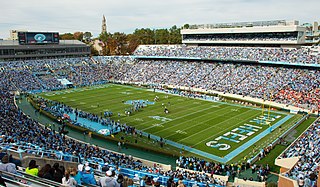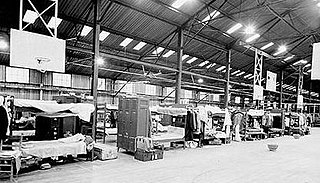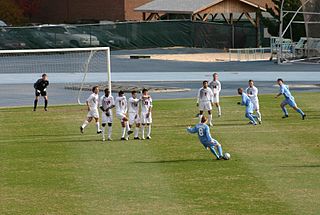
Kenan Stadium is a college football stadium located on Stadium Drive in Chapel Hill, North Carolina. Opened in 1927, it is home to the University of North Carolina at Chapel Hill's (UNC) football team, which competes in the Atlantic Coast Conference. The facility replaced Emerson Field, where the school's football program had been based since 1916. Plans for the stadium began as attendance increased. Ground was broken on the stadium in December 1926 and work completed in August 1927. The stadium hosted its first game on November 12, 1927, when the Tar Heels faced the Davidson Wildcats, where the Tar Heels won 27–0 in front of 9,000 spectators. On November 24, 1927, the stadium was officially opened and dedicated during a game where the Tar Heels hosted the Virginia Cavaliers and won 14–13.

William Donald Carmichael, Jr. Arena is a multi-purpose arena on the campus of the University of North Carolina at Chapel Hill in Chapel Hill, North Carolina, United States. It is home to four Tar Heels athletic teams: women's basketball, volleyball, women's gymnastics, and wrestling. It is named for William Donald Carmichael, Jr., a popular former school vice-president and brother of All-America basketball player Cartwright Carmichael.

The Indoor Athletic Court was the home of North Carolina Tar Heels men's basketball team from January 8, 1924, through February 17, 1938, across fifteen seasons. Due to increased demand for viewing the varsity basketball team and limited capacity at then home court Bynum Gymnasium, the university appropriated $54,482.45 to have a structure built to house the team. Then Graduate Manager of Athletics Charles T. Woollen decided to build a temporary structure with those funds and a more permanent venue later. Plans were purchased and work began in October 1923. The building, which was a completely steel structure, was built with galvanized steel sheet siding and roof. Many felt the building did not have an attractive exterior. The building featured one bathroom, no locker or dressing rooms, and no heating system, initially. Quickly the building earned a reputation for being cold during the winter and hot during the summer time. An official heating system and, later individual heaters, were added to the building, but did not help the temperature problem. The men's basketball team moved to the Woollen Gymnasium in 1939.

Robert Fetzer Field was a stadium located in Chapel Hill, North Carolina, and was the home of the lacrosse and soccer teams of the University of North Carolina at Chapel Hill, the North Carolina Tar Heels. The four teams that called Fetzer field their home have a combined total of 26 national championships.

The Charles T. Woollen Gymnasium is a building used for physical education classes, recreational activity for students, and office spaces. It was the home of North Carolina Tar Heels men's basketball team from January 2, 1939, through February 27, 1965, across twenty-six seasons. Due to increased demand for viewing the varsity basketball team and limited capacity at then home court the Tin Can, school president Frank Porter Graham and Charles T. Woollen requested public funds for a new gymnasium and women's dormitory. After being rejected at the federal level, the North Carolina Public Works would award a grant of $283,090 to build a new gymnasium and the school would have to fundraise to cover the cost's remainder. The plans for the building included multi–level building that included an attached swimming pool, along with a main lobby that would overlook the main gymnasium area. Construction stretched from 1937 to 1938 and, upon completion, was seen as "modern" and one of the highest–quality basketball facilities in the Southern Conference.

Bynum Hall is the current home of the University of North Carolina at Chapel Hill Graduate Admissions office and was the first home of North Carolina Tar Heels men's basketball team. At an executive meeting on October 2, 1903, school President Francis Preston Venable announced that former North Carolina Supreme Court justice William Preston Bynum donated $25,000 to have a gymnasium built in honor of his grandson who was a student at the university and had died due to typhoid fever. Architect Frank P. Milburn drafted plans for the structure, which were then approved by Bynum and the university's Board of Trustees. The building was designed to have a Greek architecture influence and had three stories with an above-ground basement. It originally contained a swimming pool, gymnasium, office spaces, and other rooms for various sports like boxing and fencing. The building started construction by June 1904 and was completed by February 1905.

The 1923–24 North Carolina Tar Heels men's basketball team was the fourteenth varsity college basketball team to represent the University of North Carolina (UNC) as a part of the Southern Conference (SoCon) for the NCAA season. The team went undefeated, and the season was the first played in the Tin Can. The head coach was Norman Shepard, coaching in his first and only season with the Tar Heels. Their fast play and defense won them the 1924 Southern Conference men's basketball tournament.
The 1922 North Carolina Tar Heels football team represented the University of North Carolina in the 1922 college football season. Led by second year head coaches Bob Fetzer and Bill Fetzer, the team compiled a record of 9–1 and tied for the Southern Conference (SoCon) championship. The team's quarterback was Monk McDonald.
The 1929 North Carolina Tar Heels football team represented the University of North Carolina during the 1929 college football season as a member of the Southern Conference (SoCon). The Tar Heels were led by head coach Chuck Collins in his fourth season and finished with a record of nine wins and one loss. The team scored a total of 346 points.
The 1925 North Carolina Tar Heels football team was an American football team that represented the University of North Carolina as a member of the Southern Conference during the 1925 season. North Carolina compiled a 7–1–1 record (4–0–1 against conference opponents, finished third in the conference, shut out six of nine opponents, and outscored all opponents by a total of 123 to 20. The team played its home games at Emerson Field in Chapel Hill, North Carolina.
The 1923 North Carolina Tar Heels football team represented the University of North Carolina during the 1924 college football season as a member of the Southern Conference (SoCon). The Tar Heels were led by head coaches Bob Fetzer and Bill Fetzer in their third season and finished with a record of five wins, three losses, and one tie.
The 1924 North Carolina Tar Heels football team represented the University of North Carolina during the 1924 college football season as a member of the Southern Conference (SoCon). The Tar Heels were led by head coaches Bob Fetzer and Bill Fetzer in their fourth season and finished with a record of four wins and five losses.
The 1930 North Carolina Tar Heels football team was an American football team that represented the University of North Carolina as a member of the Southern Conference during the 1930 college football season. In their fifth season under head coach Chuck Collins, North Carolina compiled an 5–3–2 record.
The 1959 North Carolina Tar Heels football team represented the University of North Carolina at Chapel Hill during the 1959 NCAA University Division football season. The Tar Heels were led by first-year head coach Jim Hickey and played their home games at Kenan Memorial Stadium. The team competed as a member of the Atlantic Coast Conference, finishing in second.
The 1947 North Carolina Tar Heels football team was an American football team that represented the University of North Carolina at Chapel Hill in the Southern Conference during the 1947 college football season. In its fifth year under head coach Carl Snavely, the team compiled an 8–2 record, finished in second place in the conference, was ranked No. 9 in the final AP Poll, and outscored opponents by a total of 210 to 93.
The 1941 North Carolina Tar Heels football team was an American football team that represented the University of North Carolina as a member of the Southern Conference during the 1941 college football season. In their sixth year under head coach Raymond Wolf, the Tar Heels compiled a 3–7 record, finished 11th in the Southern Conference, and were outscored by a total of 172 to 130.
The 1936 North Carolina Tar Heels football team represented the University of North Carolina at Chapel Hill during the 1936 college football season. The Tar Heels were led by first-year head coach Raymond Wolf and played their home games at Kenan Memorial Stadium. They competed as a member of the Southern Conference.
The 1935 North Carolina Tar Heels football team represented the University of North Carolina at Chapel Hill during the 1935 college football season. The Tar Heels were led by second-year head coach Carl Snavely and played their home games at Kenan Memorial Stadium. They competed as a member of the Southern Conference. Snavely unexpectedly resigned at the end of the season to accept a head coaching position at Cornell University. He returned to coach the Tar Heels again from 1945 to 1952.
The 1931 North Carolina Tar Heels football team was an American football team that represented the University of North Carolina during the 1931 college football season as a member of the Southern Conference. In their sixth year under head coach Chuck Collins, the team compiled an overall record of 4–3–3, with a mark of 2–3–3 in conference play.

The 1910–11 North Carolina Tar Heels men's basketball team was the first varsity college basketball team to represent the University of North Carolina. The school created a committee to determine if the school should go forward with forming a team as there was increasing pressure from students, the student run newspaper The Tar Heel, in-state schools that fielded teams who wanted to form a state league, and the University of Tennessee inquired about scheduling a game in February 1911. Equipment was purchased and installed at Bynum Gymnasium after a period of uncertainty of where the team would play its home games. Then track-and-field head coach Nathaniel Cartmell – who had little experience with basketball – was chosen to coach as there were no funds to be allocated for hiring another coach. After choosing players for the first team, Cartmell finalized the schedule in January, which was limited as many other programs had already created their schedules before the Tar Heels made their team.










